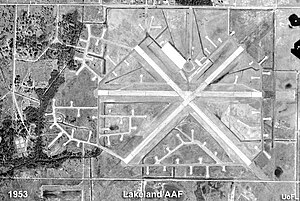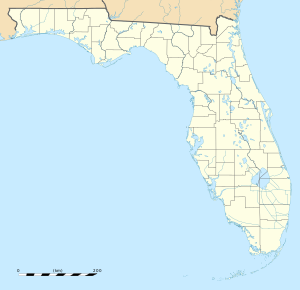Lakeland Army Air Field: Difference between revisions
→History: edited and expanded |
→References: edited and expanded |
||
| Line 51: | Line 51: | ||
{{AFHRA}} |
{{AFHRA}} |
||
{{Reflist}} |
{{Reflist}} |
||
* Shaw, Frederick J. (2004), Locating Air Force Base Sites History’s Legacy, Air Force History and Museums Program, United States Air Force, Washington DC, 2004. |
|||
* Manning, Thomas A. (2005), History of Air Education and Training Command, 1942–2002. Office of History and Research, Headquarters, AETC, Randolph AFB, Texas ASIN: B000NYX3PC |
|||
* Maurer, Maurer (1969), Combat Squadrons of the Air Force, World War II, Air Force Historical Studies Office, Maxwell AFB, Alabama. ISBN 0-89201-097-5 |
|||
* Ravenstein, Charles A. (1984). Air Force Combat Wings Lineage and Honors Histories 1947–1977. Maxwell AFB, Alabama: Office of Air Force History. ISBN 0-912799-12-9. |
|||
* [http://www.airfieldsdatabase.com/WW2/WW2%20R27b%20CO-HA.htm World War II airfields database: Florida] |
* [http://www.airfieldsdatabase.com/WW2/WW2%20R27b%20CO-HA.htm World War II airfields database: Florida] |
||
Revision as of 13:32, 28 July 2012
Lakeland Army Airfield
 Drane Field | |
|---|---|
| Part of Third Air Force | |
| Located near: Lakeland, Florida | |
 Lakeland Army Airfield in 1953, at that time unused and in its World War II configuration. Lakeland Army Airfield in 1953, at that time unused and in its World War II configuration.
| |
| Coordinates | 27°59′20″N 082°01′07″W / 27.98889°N 82.01861°W |
| Site history | |
| In use | 1942-1945 |
- For the civil airport, see: Lakeland Linder Regional Airport
- For the World War II Air Force Contract Flying School in Lakeland, see: Lodwick Field
Lakeland Army Airfield, was a World War II United States Army Air Force located 5.3 miles southwest of Lakeland, Florida.
History
On May 22, 1941, the Lakeland City Commission passed a Resolution naming the Lakeland Airport No. 2, which was under construction, Drane Field in honor of Herbert J. Drane, one of Lakeland's outstanding citizens.
The city had barely begun work on the new airport when, with war already raging in Europe, it leased the facility to the War Department. The U. S. Army Corps of Engineers improved the three existing runways and constructed the necessary buildings to operate a training facility to fly combat bombers and fighters. The new base, initially a sub-base of MacDill Field, Tampa, Florida, was named Lakeland Army Air Field. Thousands of men received part of their training here.
The organizations on the field at its inception consisted of the five squadrons comprising the 98th Bombardment Group, the Fourth Weather Squadron and the Fourth Airways Communications Detachments. A Flying Fortress group trained until 1942, then until 1944, tactical groups flying the B-26, B-25, B-24, A-20, P-51, and P-40 trained. Fighter reconnaissance groups flying P-51 Mustangs and a few Air Commando squadrons also trained at Drane Field.
See also
References
![]() This article incorporates public domain material from the Air Force Historical Research Agency
This article incorporates public domain material from the Air Force Historical Research Agency
- Shaw, Frederick J. (2004), Locating Air Force Base Sites History’s Legacy, Air Force History and Museums Program, United States Air Force, Washington DC, 2004.
- Manning, Thomas A. (2005), History of Air Education and Training Command, 1942–2002. Office of History and Research, Headquarters, AETC, Randolph AFB, Texas ASIN: B000NYX3PC
- Maurer, Maurer (1969), Combat Squadrons of the Air Force, World War II, Air Force Historical Studies Office, Maxwell AFB, Alabama. ISBN 0-89201-097-5
- Ravenstein, Charles A. (1984). Air Force Combat Wings Lineage and Honors Histories 1947–1977. Maxwell AFB, Alabama: Office of Air Force History. ISBN 0-912799-12-9.

